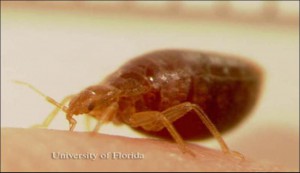
Bed bugs are small, flat blood-feeding ectoparasites of humans that are most active at night. When bed bugs are not feeding, they prefer to hide in small crevices close to where they feed, such as mattresses seams, headboards and bed frames, and furniture. For a more complete review of the biology and behavior of bed bugs, click here.
Although bed bugs can be a challenge to avoid, the likelihood of bringing bed bugs home can be reduced by following these simple steps.
Before you leave:
– Be able to identify the signs of bed bugs before you travel
– Be able to identify bed bugs
– Be able to recognize bed bug fecal spots
– Pack a flashlight to help you with inspecting your room or use the flashlight app on your smartphone. Economical LED flashlights are readily available online or in stores. One-hundred lumens is plenty of light.
When you arrive:
– Before unpacking, place luggage in bathroom and inspect your room(s)
– Be sure to flip the bed skirt and check the box spring, then mattress seams, check headboard, chair cushions and seams, luggage racks and drawers
– Pull back sheets on bed to inspect mattress
– Do not place luggage on uninspected upholstered surfaces such as furniture or bed, use luggage racks that have been inspected
– If pests are spotted notify management and change rooms/properties immediately
– Make sure new room is not adjacent to old room
When you return:
– When you return home inspect your luggage and vacuum suitcase before bringing luggage inside
– Wash all clothes in hot water immediately
If you do happen to return from travel with bed bugs, contact a pest management professional to eliminate the pest if it has become an infestation (i.e., adults and nymphs). Click here for a list of things NOT to do if you encounter bed bugs in your home.
This information was provided by Dr. Faith Oi, University of Florida
 0
0
